I used to want to change people through insights, advice-giving, lessons learned, and strategies garnered. But I realized that If I wanted to change anyone, the only person I needed to change was myself. Most of us don’t like being told what to do. We want to buy but we don’t want to be sold to. As author John C. Maxwell puts it “People change when they … Hurt enough that they have to, Learn enough that they want to, and Receive enough that they are able to.” Sometimes the only way we change is when we have hit rock bottom and change is not something we wish for but we have to swim out of the hole or we sink. It is a constant battle to stop myself from giving unsolicited advice. I try to read as much as possible, and the more I know, the more I realize that I still have a lot of work to do.
People change when they hurt enough that they have to change. People change when they learn enough that they want to change. People change when they receive enough that they are able to change. – John C. Maxwell
I like the story of the monk who shared a story that exemplifies the need to change oneself and not others. It goes like this:
When I was a young man, I wanted to change the world.
I found it difficult to change the world, so I tried to change my nation. When I found I couldn’t change the nation, I began to focus on my town. I couldn’t change the town, and as an older man, I tried to change my family.
Now, as an old man, I realize the only thing I can change is myself, and suddenly I realize that if long ago I had changed myself, I could have made an impact on my family. My family and I could have made an impact on our town. Their impact could have changed the nation, and I could indeed have changed the world.
Like the monk in the above story, we constantly look at the window instead of in the mirror. We want to inspire and influence others when we have not inspired ourselves or lead a life worth following. Like the monk, I have come to peace with the fact that people change when they are ready, and the only way to influence anyone is to be the change you want to see in the world. Instead of trying to change people to read, I would instead read. Instead of telling them to run marathons, I would run marathons. Instead of ranting about the ills of using social media, I use my time judiciously, and when I am asked how I have the time, I confess that not using social media might be a factor.
You can’t change another person. 1
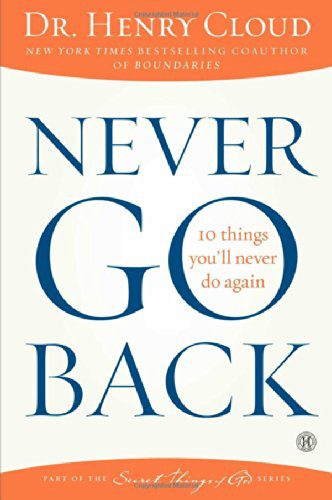
Try to get someone to be or do something they do not wish to be or do. Yet we know it would be good for them—if they would just “get it.” Right? Probably. But they would have to get it. And that is the problem.
It is about you realizing that you may be in a relationship with someone who isn’t listening or doesn’t desire to change, or doesn’t want what you want for him or her. It’s about being in a push-pull scenario where you are trying to get someone to be different. It is about understanding in your own mind that people who go through this awakening of realizing they can’t change another person never go back . They realize the truth that . . .
“I can’t get someone to do something they don’t choose to do—either because they can’t or because they don’t desire to do it.”
We can never take over another person’s freedom to choose. Once we understand this, we never go back to thinking we can. We get in touch with the way God has designed the universe. People are not robots; they are free to choose what they want and what they will do and what they won’t do. When we realize that, we stop trying to do what will never work, which is trying to change people into something they do not want to be or convince them to do something they do not want to do. It never works. While we can influence them, ultimately we cannot change them.
“Never go back” to thinking you can force someone into anything. Repent from trying to control others. You will be glad you did.”
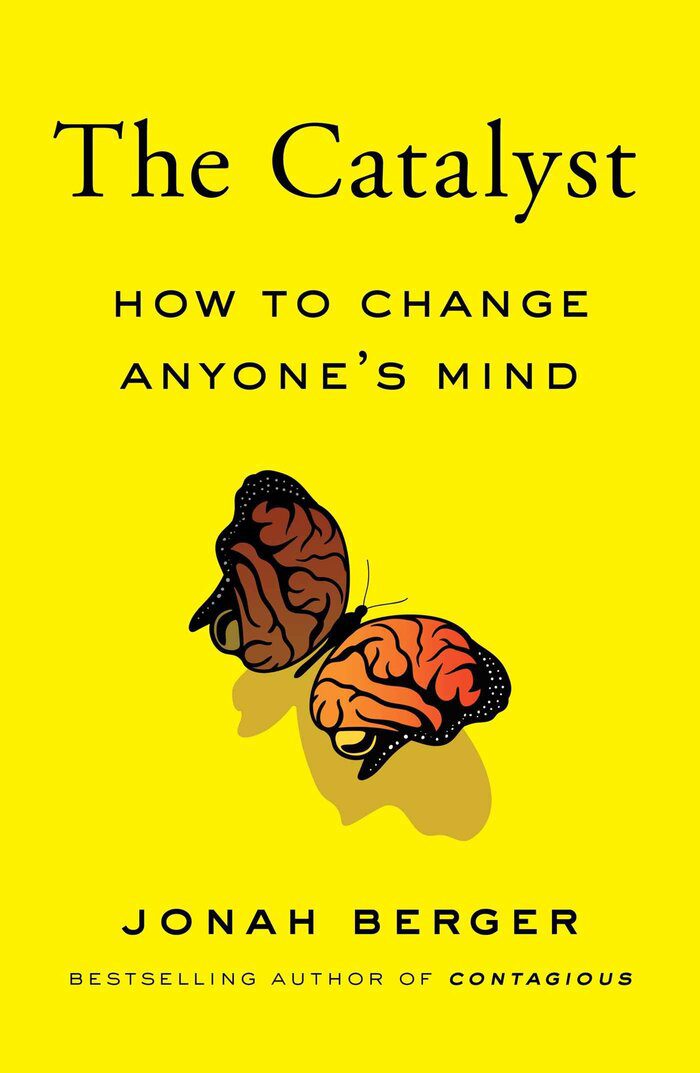
In The Catalyst: How to Change Anyone’s Mind 2, Wharton School of the University of Pennsylvania, Professor Jonah Berger describes a brilliant framework for effecting change that he calls the REDUCE Framework. REDUCE is an acronym for REDUCE (Reactance, Endowment, Distance, Uncertainty, and Corroborating Evidence. Berger observed that successful change isn’t about pushing harder or exerting more energy. It’s about removing barriers. Overcoming resistance by reducing friction and lowering the hurdles to action.
Successful change is about removing barriers. Overcoming resistance by reducing friction and lowering the hurdles to action.
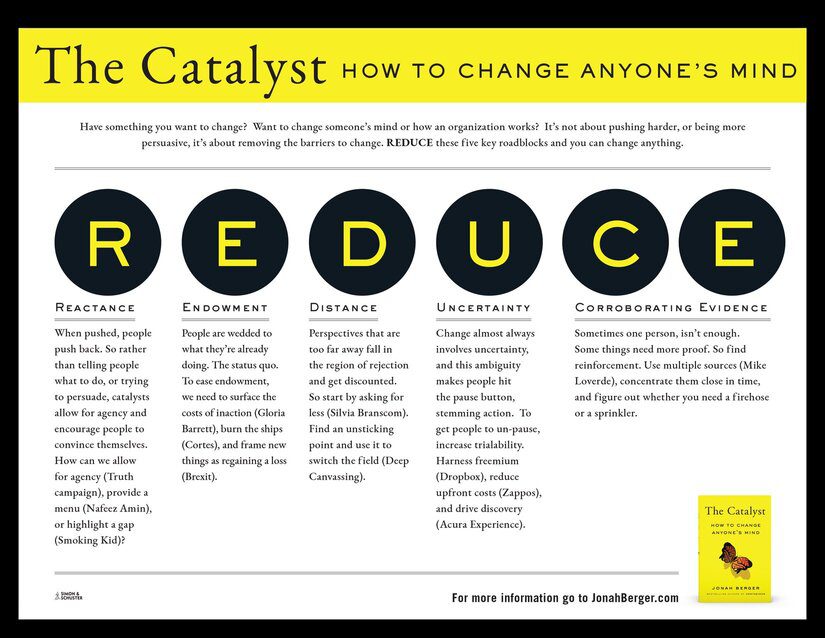
The five ways to be a catalyst can be organized into an acronym. Catalysts
- reduce Reactance,
- ease Endowment,
- shrink Distance,
- alleviate Uncertainty, and
- find Corroborating Evidence.
Principle 1: Reactance
Restriction generates a psychological phenomenon called reactance. An unpleasant state that occurs when people feel their freedom is lost or threatened
When pushed, people push back. Just like a missile defense system protects against incoming projectiles, people have an innate anti-persuasion system. Radar that kicks in when they sense someone is trying to convince them. To lower this barrier, catalysts encourage people to persuade themselves.
Pushing, telling, or just encouraging people to do something often makes them less likely to do it.
Principle 2: Endowment
Whenever people think about changing, they compare things to their current state. The status quo. And if the potential gains barely outweigh the potential losses, they don’t budge.
As the old saying goes, if it ain’t broke, don’t fix it. People are wedded to what they’re already doing. And unless what they’re doing is terrible, they don’t want to switch. To ease endowment, or people’s attachment to the status quo, catalysts highlight how inaction isn’t as costless as it seems.
Change is hard because people tend to overvalue what they have: what they already own or are already doing.
Principle 3: Distance
Start with a place of agreement and pivot from there to switch the field. Connecting to these parallel directions should move them enough to see the initial topic differently.
People have an innate anti-persuasion system, but even when we just provide information, sometimes it backfires. Why? Another barrier is distance. If new information is within people’s zone of acceptance, they’re willing to listen. But if it is too far away, in the region of rejection, everything flips. Communication is ignored or, even worse, increases opposition.
People search for, interpret, and favor information in a way that confirms or supports their existing beliefs
Principle 4: Uncertainty
Change often involves uncertainty. Will a new product, service, or idea be as good as the old one? It’s hard to know for sure, and this uncertainty makes people hit the pause button, halting action. To overcome this barrier, catalysts make things easier to try. Like free samples at the supermarket or test drives at the car dealership, reducing risk by letting people experience things for themselves.
People are risk-averse. They like knowing what they are getting, and as long as what they are getting is positive, they prefer sure things to risky ones. Even if the risky choice is better, on average.
Principle 5: Corroborating Evidence
Sometimes one person, no matter how knowledgeable or assured, is not enough. Some things just need more proof. More evidence to overcome the translation problem and drive change. Sure, one person endorsed something, but what does their endorsement say about whether I’ll like it? To overcome this barrier, catalysts find reinforcement. Corroborating evidence.
If one person says you have a tail, you laugh and think they’re crazy. But if three people say it, you turn around to look.
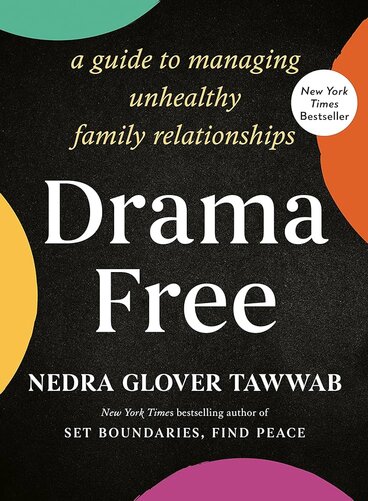
To be healthy 3, you must manage what you can, but never other people and how they choose to live. Even when you love someone and believe you know what’s best for them, you cannot control them. Autonomy is a healthy part of relationships. A wonderful way to support others is to allow them to be as they are. Knowing you can choose how to help people frees you to develop your own ideas about
what’s possible in your relationships.
Meditations
Daily Calm with Tamara Levitt – Envy
- The grass always looks greener on the other side. Envy is often rooted in skewed or exaggerated perceptions; psychologists call this Cognitive distortion. The result is emotional suffering when we indulge in black-and-white thinking or over-generalization. These faulty perceptions can fester in a funk of envy, sadness and even anger.
- When noticing and labelling envy, we create emotional distance between envy and ourselves. Consciously challenge your distorted perception, remembering that things are not what they seem. Those who seem to have it all seem to have suffering we don’t see. Envy emerges when we emphasize what we don’t have, but by devoting attention to the many things that we do have, we invite feelings of happiness, pride and love. Envy is often a result of an incomplete perspective.
‘Love looks through a telescope; envy, through a microscope.’ – Josh Billings
Daily Jay with Jay Shetty – The Raft
- Sometimes, what got us here won’t get us there; it might even hold us back. And to move on, we have to let go. In life, on our own great journey, we often feel compelled to use the same old approach or strategy, even when there are new obstacles in our path. There are so many rafts that we might be carrying like, like a job that was once engaging and fulfilling but has gotten stale or a friendship that was supportive and enjoyable in the past, but now you’ve outgrown one another.
- Change is often challenging, but it is necessary for growth, and that includes leaving some things behind. So whatever jungle you’ve come to, you may need to drop the raft.
Daily Trip with Jeff Warren
Podcast
- How To Escape Mediocrity, Find Purpose & Master Power (Get Ahead Of 99% Of People) | Robert Greene – Tom Biliyeu
Languages
Español
Français
All the best in your quest to get better. Don’t Settle: Live with Passion.
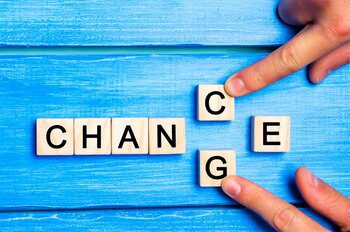

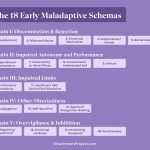
Comments are closed.